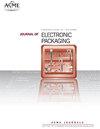A Comparison of Biaxial Bending Strength of Thin Silicon Dies in the BoR and PoEF Tests
IF 2.3
4区 工程技术
Q3 ENGINEERING, ELECTRICAL & ELECTRONIC
引用次数: 0
Abstract
This paper aims to demonstrate the biaxial bending strength test on thin silicon dies using the classic ball-on-ring (BoR) test, and discuss it in detail by comparing those results with the newly-proposed point load on elastic foundation (PoEF) test. The geometric linear and nonlinear solutions to the BoR test are reviewed and also provided with theoretical and numerical formulations, respectively. Three different thicknesses (t = 42 μm, 57 μm and 82 μm) of the thin silicon dies (with a size of 10 mm × 10 mm) are tested in the BoR test, and their bending strengths, load-displacement curves and failure modes are presented and thoroughly discussed with a comparison of the published data from the PoEF test. It is found that, for the bending strengths of 57 μm and 82 μm-thick dies, the data from both the BoR and PoEF tests are very consistent, but not for 42 μm-thick dies with a relatively lower value in the BoR test. This lower strength value in the BoR test is attributed to the more pronounced local buckling effect than the PoEF test. Based on that, it can concluded that the PoEF test is better and more reliable than the conventional BoR as for testing the ultra-thin silicon dies, even though both tests are identical for the regularly thin dies.薄硅模具在BoR和PoEF试验中的双轴弯曲强度比较
本文采用经典的环上球(BoR)试验对薄硅模具进行了双轴弯曲强度试验,并与新提出的弹性基础点荷载(PoEF)试验结果进行了比较。回顾了BoR试验的几何线性解和非线性解,并分别给出了理论和数值公式。对尺寸为10 mm × 10 mm的薄硅模(t = 42 μm、57 μm和82 μm)进行了BoR试验,给出了3种不同厚度(t = 42 μm、57 μm和82 μm)的弯曲强度、载荷-位移曲线和破坏模式,并与已发表的PoEF试验数据进行了比较。结果表明,对于57 μm和82 μm厚的模具,BoR和PoEF测试的数据非常一致,但对于42 μm厚的模具,BoR测试的数据相对较低。与PoEF试验相比,BoR试验中较低的强度值归因于更明显的局部屈曲效应。基于此,可以得出结论,PoEF测试比常规的BoR测试在超薄硅模具测试中更好、更可靠,尽管这两种测试在常规薄模具测试中是相同的。
本文章由计算机程序翻译,如有差异,请以英文原文为准。
求助全文
约1分钟内获得全文
求助全文
来源期刊

Journal of Electronic Packaging
工程技术-工程:电子与电气
CiteScore
4.90
自引率
6.20%
发文量
44
审稿时长
3 months
期刊介绍:
The Journal of Electronic Packaging publishes papers that use experimental and theoretical (analytical and computer-aided) methods, approaches, and techniques to address and solve various mechanical, materials, and reliability problems encountered in the analysis, design, manufacturing, testing, and operation of electronic and photonics components, devices, and systems.
Scope: Microsystems packaging; Systems integration; Flexible electronics; Materials with nano structures and in general small scale systems.
 求助内容:
求助内容: 应助结果提醒方式:
应助结果提醒方式:


